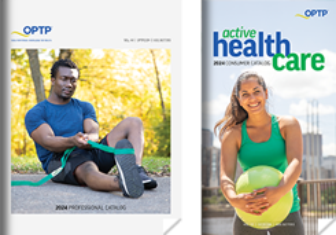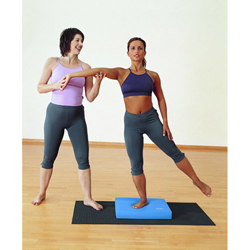Over one-third of runners sustain at least one soft tissue injury over the course of a year.1,2 The following three types of injuries are some of the most common, and ones that you’ll likely experience at some point if you haven’t already. But don’t fear, we’ve identified therapy products for each condition to help expedite the recovery process.
Iliotibial Band Syndrome (ITBS)
ITBS is an overuse injury that presents itself in up to 12 percent of runners each year, and it is the most common cause of lateral knee pain in running athletes.4 Significant risk factors include downhill running and an abrupt increase in running distance, pace, or frequency.
One of the best ways to tackle Iliotibial Band Syndrome is through myofascial release with a foam roller. Foam roller therapy is an essential aide for several running injuries, including ITBS.3 If you’re new to foam rolling, it can be a bit overwhelming as foam rollers come in all shapes, sizes, and densities. This page provides a brief introduction to foam rollers to help you get started.
Once you’ve found your roller, take advantage of the many educational resources out there that will help you use it. Foam Roller Techniques by Michael Fredericson, MD features color illustrations and clear, step-by-step instructions to effectively massage and stretch a runner’s most important muscle groups, including the IT Band. Check out the video below and see how to massage the IT Band and other sensitive areas with your roller.
Shin Splints & Ankle Sprains
About 10-20 percent of all runners experience a bout of medial tibial stress syndrome (MTSS), or shin splints, at some point during their career.8 For inflammatory conditions like shin splints or ankle sprains, ice, rest, and orthotic shoe inserts are commonly prescribed.
Kinesiology taping, however, offers additional options for pain modulation and return to function. Unlike conventional tapes, SpiderTech® kinesiology tape has the same weight, thickness, and elasticity as human skin, allowing it to work naturally with the body’s own sensory system to reduce pain and provide natural stability. It’s available in more than a dozen pre-cut applications, including designs for the ankle as well as a foot arch and calf combo.
Another way to address shin splints, ankle sprains, and calf strains is with the OPTP SlantTM. This pair of lightweight foam wedges allows for simple stretching exercises. Their 18-degree incline is ideal for stretching the hamstrings and calves to help with tight fascia and strengthening of the tissues in this region.
Plantar Fasciitis
Plantar fasciitis is the third most frequent injury among runners.5 It is characterized by inflammation in the long tendon at the bottom of the foot, which stretches from the heel to the toes. Although the etiology of this condition is controversial, several risk factors, including high body weight and reduced ankle dorsiflexion, have been associated with increased incidence rates.6 Research suggests that conducting tissue-specific plantar fascia stretching several times a day helps alleviate and prevent pain due to chronic plantar fasciitis.7
With a cradle design that encompasses the foot, the Stretch-EZ™ is a unique stretching aide that assists with plantar fasciitis, as well as calf, thigh, hip and low back strains and injuries. By inserting the foot into the cradle and pulling back, it produces superior dorsiflexion of the toes that stretches the plantar fascia. Since the Stretch-EZ features multiple strap loops, it allows you to safely and easily control each stretch.

A lot of runners are told to use a tennis ball or lacrosse ball for their plantar fasciitis. While this can be a viable option, there are plenty of products out there designed specifically for massage of the foot. These Half Balls are the ideal texture and firmness for that purpose. The flat bottom ensures they won’t roll away during use, making it easier to target specific areas for a better massage and stretch of the plantar fascia.
Back Up and Running
Perhaps you’ll be one of the fortunate ones who’s able to steer clear of these running injuries. But if not, you now have some basic knowledge to guide you on the path to recovery. Hopefully, with consistent use of the right therapy tools and a mental approach grounded in patience, you’ll be back out on the pavement and trails before you know it.
* For your safety, always consult with your healthcare professional before starting any type of exercise or stretching program, especially if you have any health concerns. Products mentioned in this article are intended to provide therapeutic relief but do not guarantee cure of condition.
References
1 Buist I, Bredeweg SW, Lemmink K, et al. Predictors of running-related injuries in novice runners enrolled in a systematic training program: a prospective cohort study.
Am J Sports Med. 2010; 38(2):273-280.
2 Rauh MJ, Koepsell TD, Rivara FP, et al. Epidemiology of musculoskeletal injuries among high school cross-country runners. Am J Epidemiol. 2006; 163(2):151–159.
3 Fredericson M, Weir A. Practical management of iliotibial band friction syndrome in runners. Clin J Sport Med. 2006; 16(3):261-268.
4 Fredericson M, Wolf C. Iliotibial band syndrome in runners. Sports Med. 2005; 35(5):451-459.
5 Ribeiro AP, Trombini-Souza FT, Tessutti VD, et al. The effects of plantar fasciitis and pain on plantar pressure distribution of recreational runners. Clinical Biomechanics.
2011; 26:194-199.
6 Riddle DL, Pulisic M, Pidcoe P, et al. Risk factors for plantar fasciitis: a matched case-control study. Journal of Bone & Joint Surgery. 2003; 85A (5):872-877.
7 DiGiovanni BF, Nawoczenski DA, Malay DP, et al. Plantar fascia–specific stretching improves outcomes in patients with chronic plantar fasciitis: a prospective clinical trial with two-year follow-up. J Bone Joint Surg Am. 2008; 88:1775–81.
8 Hubbard TJ, Carpenter EM, & Cordova ML. Contributing factors to medial tibial stress syndrome: a prospective investigation. Med Sci Sports Exercise. 2009; 41(3): 490-496.







